
Cerdo Iberico

Cordoba




Sanlucar






Cadiz






Granada



Jerez

Puerto



Malaga


Sevilla
(Sanlucar de Mayor)


Sevilla





Almaria, San Jose



Andalucía (Andalusia) Food, cooking and flamenco
Cadiz - Sanlucar de Barrameda - Cordoba - Malaga - Ronda - Jerez - Granada - El Puerto -Sevilla(Seville), often overlooked, Almaria and the Cabo de Gato
Andalucia is the deep south of Spain and home of flamenco. It is the land of salads, fried fish and seafood and the famous cold soup gazpacho, not to mention sherry.
![]()
Fritura
is fish and/or seafood fried in thin batter.
Parillada
is a selection of griddled fish and seafood.
The commonest
way of cooking fish is "a la plancha", simply griddled and served
drizzled with olive oil, garlic, lemon and parsley.
Pescado a la sal a whole fish cooked in a block of salt. (Many sea salt pans are to be found in Andalucia, giving a readily available supply).
Gazpachocold
soup of tomatoes, garlic, cucumber, peppers and onion
The most
prized fish of eastern Andalucia is the Mero, Restaurante Tempranillo Website
in San Jose serves it with small clams in a emulsified (egg and oil) clam
sauce, accompanied by thin chips.
Moros y Cristianos - (moors and christians) rice with black beans, which reminds us of the strong arab influence in Andalucia, long occupied by the moors.
Cadiz(seafood
- tapas in the old town and restaurants behind the beach in the newer town,
we like Mariscos La Marea, Paseo Maritimo 1), "El Faro" website
is a top class elegant restaurant (formal with slightly over fussy service)
in an unprepossessing street near "La Caleta" (junction of Venezuela and
San Felix) make excellent tortillitas and specialise
in "a la sal" dishes as well as more innovative creations).
For something cheaper try "Grimaldi" in Calle Libertad just by the central
market.![]()
![]()
![]()
![]()
![]()
![]()
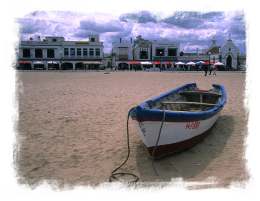 Sanlucar
de Barrameda
Sanlucar
de Barrameda![]() - restaurants
overlooking the Guadalquivir
- restaurants
overlooking the Guadalquivir ![]() along
Bajo de Guia
along
Bajo de Guia ![]() -"Casa Bigote", "Mirador de Donaña", "Poma", "Secundina" and others,
there are of course restaurants around the plazas of the town and in a
couple of places, in a converted bodega.
-"Casa Bigote", "Mirador de Donaña", "Poma", "Secundina" and others,
there are of course restaurants around the plazas of the town and in a
couple of places, in a converted bodega.
Cordoba.![]() Cordoba's
juderia or old quarter is a maze of narrow alleys where a number of excellent
restaurants are housed in the open interior patios of old manor houses.
Try them for breakfast, lunch or dinner and if you get the right waiter
the service will be as entertaining as the food is enjoyable. One of our
favourite dishes is "cardos
con gambas y almejas", cardoon in seafood stock with baby clams
and prawns.
Cordoba's
juderia or old quarter is a maze of narrow alleys where a number of excellent
restaurants are housed in the open interior patios of old manor houses.
Try them for breakfast, lunch or dinner and if you get the right waiter
the service will be as entertaining as the food is enjoyable. One of our
favourite dishes is "cardos
con gambas y almejas", cardoon in seafood stock with baby clams
and prawns.
Cordoban
restaurants: "Restaurante de Federacion de Penas"![]() ,
"El Churrasco", "Los Deanes", "Casa Pepa de la Juderia".
,
"El Churrasco", "Los Deanes", "Casa Pepa de la Juderia".
Perhaps the
best known restaurant in Cordoba is "La Caballo Rojo"![]() ,
near the Mesquita
,
near the Mesquita![]() ,
serving mozarabic dishes (typically meat and game in warmly spiced, sweet,
fruity or Pedro Ximenez sauces),
a little more formal than some and a popular night out destination for
animated groups of Cordobans. "Bodegas Campos" is also very good <website>.
,
serving mozarabic dishes (typically meat and game in warmly spiced, sweet,
fruity or Pedro Ximenez sauces),
a little more formal than some and a popular night out destination for
animated groups of Cordobans. "Bodegas Campos" is also very good <website>.
(the main
restaurants in the Juderia are signposted for pedestrians - it goes without
saying that here as in most spanish old quarters the car should be parked
and forgotten until you want to move on).
Flamenco
can often be seen in the patio at "El Cardenal" Torrijos 10, next to the
Mezquita. Although aimed at tourists, the quality can be very good.<website>
Cordoba is
quite traditional and much is closed on Sunday evenings.
Hotels
Malaga. ![]() The
parador
Gibralfaro has an excellent restaurant and there are some smart bars, some
rather reminiscent of English pubs, below it in the town. The old town
east of the Guadalmedina has many good bars and restaurants. We liked "Cortijo
de Pepe" on Plaza de la Merced for tapas and "El Chinitas"
<website>
on Calle Moreno Monroy 4-6. (95 221 09 72) for a full meal or tapas in
a traditional environment (smart). "El Chinitas" is just to the south of
Plaza de la Constitution off Marques de Larios. Remember to order a Malaga
brandy when here, "1866" being a good example.
The
parador
Gibralfaro has an excellent restaurant and there are some smart bars, some
rather reminiscent of English pubs, below it in the town. The old town
east of the Guadalmedina has many good bars and restaurants. We liked "Cortijo
de Pepe" on Plaza de la Merced for tapas and "El Chinitas"
<website>
on Calle Moreno Monroy 4-6. (95 221 09 72) for a full meal or tapas in
a traditional environment (smart). "El Chinitas" is just to the south of
Plaza de la Constitution off Marques de Larios. Remember to order a Malaga
brandy when here, "1866" being a good example.
Ronda
has
an excellent (modern) parador and "Pedro Romero" opposite the bullring,
named after the famous bullfighter.
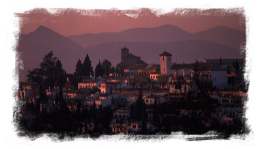 Granada.
The
parador, in the grounds of the Alhambra
Granada.
The
parador, in the grounds of the Alhambra![]() ,
if you can get in or Mirador de Morayna in the Albaicin
,
if you can get in or Mirador de Morayna in the Albaicin![]() .
It is also interesting to drive out and up to Pico de Veleta for a drink,
snack and mountain views.
.
It is also interesting to drive out and up to Pico de Veleta for a drink,
snack and mountain views.![]() But don't expect luxury in the mountains, where it's too high to pump water
and generally below zero.
But don't expect luxury in the mountains, where it's too high to pump water
and generally below zero.
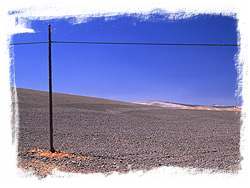
The
bustling sherry town of Jerez is
sometimes overlooked but a short stay in the excellent Hotel Jerez website
(now
back to 5 stars, excellent restaurant) allows for a pleasant if rather
long walk down Avenida Alcalde Alvaro Domecq to the innovative "El Gallo
Azul"![]() tapas
bar <browse menu> with restaurant upstairs
(junction of Larga and Santa Maria) and on to Plaza del Arenal and the
alcazar (you could make the fascinating "camera oscura" there an objective),
with the old town beyond.
tapas
bar <browse menu> with restaurant upstairs
(junction of Larga and Santa Maria) and on to Plaza del Arenal and the
alcazar (you could make the fascinating "camera oscura" there an objective),
with the old town beyond.
El
Puerto de Santa Maria. ![]() We
stay at "Hotel Monasterio San Miguel",
We
stay at "Hotel Monasterio San Miguel", ![]() only
a few hundred yards from the bustling restaurant area (walk down Calle
Chanca and turn right) along the Rio Guadalete at Calle Ribera del Marisco
only
a few hundred yards from the bustling restaurant area (walk down Calle
Chanca and turn right) along the Rio Guadalete at Calle Ribera del Marisco![]() , mostly seafood but don't overlook the impressive asador. Cadiz's El Faro
has a sister restaurant "El Faro del Puerto" up beyond the bullring (Carretera
Fuenterrabia/Calle Valdes, just walkable, taxi better), set in the edge
of a park.
, mostly seafood but don't overlook the impressive asador. Cadiz's El Faro
has a sister restaurant "El Faro del Puerto" up beyond the bullring (Carretera
Fuenterrabia/Calle Valdes, just walkable, taxi better), set in the edge
of a park.
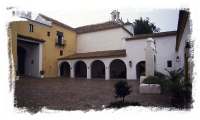 Sevilla.
(Seville)
Tapas in "Triana"
Sevilla.
(Seville)
Tapas in "Triana" ![]() is
the "must do" here. Calle del Betis and Calle San Jacinto on the south
bank of the Guadalguivir. "Kiosko de las Flores" does wonderful fried fish.
is
the "must do" here. Calle del Betis and Calle San Jacinto on the south
bank of the Guadalguivir. "Kiosko de las Flores" does wonderful fried fish.
In the "La
Macarena" area "El Rinconcillo" is said to be the first (1670) tapas bar
(Plaza de los Terceros) but remember its a pilgrimage place for tourists
so be prepared to politely decline the waiters sales line of a whole meal,
there are many other bars to try! Here's one not to try![]() .We
like to stay in the "Casas de la Juderia"
.We
like to stay in the "Casas de la Juderia" ![]()
Dorada a la Sal
Take enough salt to bury the fish, put half the salt in a large casserole and make a depression for the scaled and gutted fish, which is then buried. A little water can be sprinked on the salt to consolidate it.Cook in a medium oven for about 40 minutes for an average sized fish. Break open the salt and serve with potatoes.
Gazpacho
soak a slice
of bread per 1 lb of tomatoes for an hour
RIPE plum
tomatoes skinned and seeded
1 garlic
clove per pound of tomatoes
a little
good Spanish extra virgin olive oil (I like Carbonell or the one the paradores
sometimes sell.
a good splash
of good sherry vinegar
salt
1 cup of
water per pound of tomatoes
blend and
refrigerate
serve with
bowls of chopped onion, cucumber, green pepper &
and olive
oil crutons.
(There is
also a white garlic based version).
Clams in
sherry
Fry finely
chopped onion and garlic in olive oil, add seeded, skinned and chopped
plum tomatoes and some paprika. Cook down and then add dry sherry (try
dry oloroso). Bring to the boil and then add the clams and cook until
opened. Serve with bread.
Iberico and Serrano ham
"Serrano ham" comes from the white pigs of Trevelez (Sierra Nevada) and Teruel (Aragon).
"Iberico ham" comes from the black Iberian pigs (Cerdo Iberico) extensively farmed in the hills of Andalucia (and on the extensive dehesas of Extremadura) near Huelva, feeding on the acorns of the cork oaks, the bark of which is also used to make wine corks. Jabugo (Sierra Morena) is the most famous of some 30 producers, who are considered to produce some of the best Spanish ham. The dry mountain air with low night time temperatures contributes to the salt curing of the ham and the production of the penicllium mould that forms on it.
Bellota is 75% Iberian, with 40% of weight gained in extensive conditions.
Recebo up to 30% of fatening on grain.
Pienso/cebo/campo grain fed Iberian ham.
Walking in the Sierra Aracena
A range of fortified wines made from the palomino fino[1] grape on the chalky soil around Jerez (hair-eth), Sanlucar de Barrameda and El Puerto de Santa Maria. (15-17%). Sherry does not come in vintages like other wines. It is aged in a "solera" system where the wine drawn off from the oldest barrels is topped up from the next oldest and so on. This gives both a complex wine and a consistent one. The vintage year of a sherry can therefore arguably be said to be the foundation year of the bodega!
For seafood or ham:-
Manzanilla
(manth-are-knee-ah) fresh, crisp and salty, made from coastal grapes at
Sanlucar de Barrameda. Great with tapas, seafood or on its own. Serve chilled.
Does not keep, finish the bottle ! (A further aged version is labelled
"pasada" rather than "fina" and it is even possible to have a "manzanilla
amontillada".)
Fino, light clean
aperitif wine. Serve chilled. Keeps one week to one month once opened.
For drinking alone:-
Amontillado, darker
and nutty. Serve slightly chilled.
Palo Cordato,
a rare type with a raisin palette.
Oloroso, mellow
and nutty.Keeps for several weeks once opened. In my opinion look for a
"Dry Oloroso" Drink with heavy red meat or on its own.
Sweetened:-
Pale Cream, a
fino sweetened with Ximenez grapes that have not been sun dried.
Cream, Amontillado or
Oloroso blended with Ximenez to give a warm sweet result. Aunties favourite
!
Dessert wine:-
Pedro Ximenez
(him-en-eth) heavy dessert wine, perfect with raisins and ice cream or
in mozarabic sauces.
Remember that the dry
finos etc. do not keep long. Avoid buying from a low turnover off-license.
Drink as soon as possible once opened.
1] Palamino fino is 90%
of production. Other grapes are Palamino Jerez, Listan and Pedro Ximenez.
A small amount of sweet Moscatel sherry is also produced, mainly for export.
Moscatel is also used to sweeten other sherry due partly to the shortage
of Ximenez.
Table wines
In Andalucia,
if you want a change from sherry, look out for unusual white table wines
made from sherry grapes, try "Castillo de San Diego" (palamino grape) or
"Marques de las Sierras" (Montilla-Moriles, using Pedro Ximenes grapes).
There is a friendly rivalry between Cordoba and Sevilla, so it may be diplomatic
to drink sherry in Jerez and Sevilla ; manzanilla in Sanlucar and montilla
in Cordoba and Granada.
Fritura - The fried fish of Western Andalucia
Sevilla and Càdiz are probably the best places to sample this speciality. The pieces of fish should be thinly battered and the finished product crisp and dry enough to serve on a paper napkin without leaving grease stains. A good place to sample this in Sevilla is the freiduria "Kiosko De Las Flores" at the very edge of the Triana barrio near the Puente de Isabel II (Triana bridge) on the river front.
Order a mixed plate of fish and seafood or you may find dogfish flavoured with cumin, an excellent combination (cazon en adobo) or "Bienmesabe" (literally- "it tastes good to me") marinated fried fish.
Accompany with a cold beer or try a bottle of table wine made from the sherry grape "palomino" . Castillo de San Diego by Barbadillo is a commonly available example.
Fried "Fish and Chips" did not become established in England until the 1800's and I wonder if this British institution is in fact an introduction from Spain, carried over with the sherry trade.
Tortillitas de camerones
A Càdiz speciality, tortillitas are small flat fritters made from flour and egg flavoured with the tiny Càdiz prawns, cooked in a saltén (thin frying pan). They may give the expanation as to how the word tortilla came to mean corn fritters in the new world.
Flamenco, often considered the "european blues", has its roots in India along with the Gitanos who perform it.
Over the centuries, despite much persecution, the musical cultures of Andalucia and the Gitano have combined to create flamenco, now the authentic art form of Andalucia, although many appreciate it all over Spain. (When the cantor (singer) "Camarón de la Islas" died flags flew at half mast all over the country).
Flamenco is a robust combination of song, dance and music that overcomes lingustic barriers and appeals direct to the emotions. Flamenco is not the polished polite music of the conservatoire. Flamenco is not the superficial, eager to please music of "pop". Flamenco isn't "nice".
At its best, flamenco strikes straight at your soul.
If you would like to prepare yourself try:-
Rough Guide to Flamenco
(CD)
Enrique Morente
- Rafael Riqueni - Jorge Pardo - Tomasa La Macanita
Carmen Linares
- Ketama - Camarón - Miguel Poveda - Pata Negra
Duquende
- Jose Soto - Chano Lobato - Carlos Benavent
Potito -
Pepe Habichuela - Diego Carrasco - Pacote
![]()
![]()
 "Flamenco"
by Carlos Saura (Video)
"Flamenco"
by Carlos Saura (Video)
Leading
exponents of the art come together for a series
of
powerful performances. Includes dancing by the now
world
famous Joaquin Cortes. Beautifully filmed.
 "My
Songs and a Poem" by Estrella Morente (CD)
"My
Songs and a Poem" by Estrella Morente (CD)
One
of the best recent flamenco recordings
Listen
to the audio clips at Amazon.
"The Flamencos
of Cadiz Bay" by Gerald Howson (book)
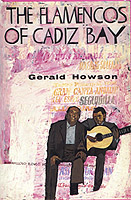 Gerald
Howson worked in Spain between 1954 and 1957, returning to England to exchange
his guitar for a camera only when he became ill. While there, he entered
fully, musically and romantically[1], into the flamenco way of life in
Cadiz. His book is a fascinating insight into that Andalucian way of life.
Gerald
Howson worked in Spain between 1954 and 1957, returning to England to exchange
his guitar for a camera only when he became ill. While there, he entered
fully, musically and romantically[1], into the flamenco way of life in
Cadiz. His book is a fascinating insight into that Andalucian way of life.
1]
"Out in the street there was nothing but the empty road disappearing into
the darkness towards the lights of Cadiz in the distance. We could hear
the murmur of the sea stretching along on either side of us.
'They
tell me you have been seeing my gitana' he said. 'I cannot tell you the
disgracias (unhappiness) I have suffered with her over the years. She's
a bad one, but I can't help loving her. Why not leave her to me, eh? I
know her at least, and what is one woman from the Sala more or less to
a man like you? What do you know of her or our troubles?'
We
walked on in silence."
"This
beautiful and exuberant memoir does honour to the flamenco way of life"
Sunday Times (London)
![]()
![]()
"Duende" Jason
Webster (book)
 Jason
Webster was born in San Fransico and grew up in England and Germany. After
living in Italy and Egypt he went to Spain to learn flamenco. The book
is a autobiography/novel of his experiences in Alicante, Madrid and finally
Andalucia, searching for the powerful state of ecstacy and desperation
that is "duende" and finding passion, drugs and life on the edge.
Jason
Webster was born in San Fransico and grew up in England and Germany. After
living in Italy and Egypt he went to Spain to learn flamenco. The book
is a autobiography/novel of his experiences in Alicante, Madrid and finally
Andalucia, searching for the powerful state of ecstacy and desperation
that is "duende" and finding passion, drugs and life on the edge.
"A
woman stands at the back of the stage and approaches the audience as the
guitars play on. Raising an arm above her head, she stamps her foot hard,
sweeps her hand down sharply to the side and stares at us in defiance.
The music stops and everyone falls silent.
Power
emanates from her across the square. Breathing hard, legs rooted to the
ground, chin raised, eyes bright, her face a vivid expression of pain.
Everyone in the audience focuses on her as she stands motionless, leaning
forward slightly, head thrust back, black hair falling loosely over her
dark yellow dress. Stretching her arms down at her sides, she tenses her
hands open, although recieving or absorbing some invisible energy she needs
to continue. For a moment I think she might never move,need never move
even, so strong is the spell she has cast over us..."
Hardback![]()
![]()
Paperback![]()
![]()
See also
:-
Andalucian
cookery book
Cookery
reference books
Cheese
Wine
Walking
in Spain
Spanish
photos
Spanish
pronouciation & general guidebooks
Food of:-
Andalucia
Asturias
Basque
Country
Canary Islands Castile
Catalonia
& Balearics Extremadura
Galicia
Valencia
Tapas
Glossary
Books